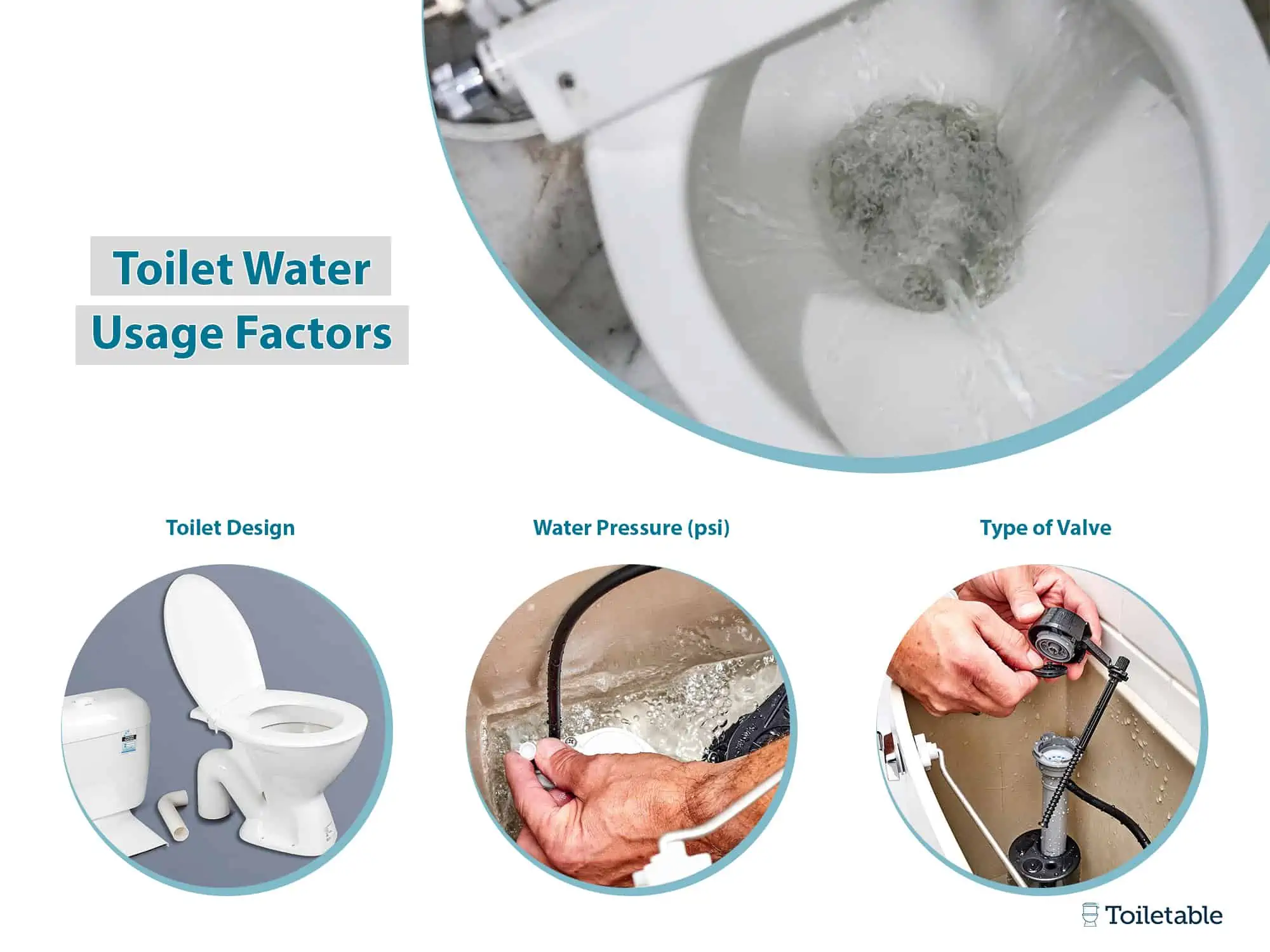Toilet flushes are one of the biggest water wasters in the home. Though the Environmental Protection Agency (EPA) has limited the maximum water usage per flush to 1.6 gallons, this can still add up if there are multiple individuals in your household.
How much water is used by your toilet depends on the size of your home and what kind of plumbing fixtures you have in your house.
Let’s take a look at some of the main factors that determine how much water your toilet uses.
Page Contents
Factors Affecting Toilet Water Usage

Toilet Design
Toilets come in two main styles: gravity and pressure-assist. Gravity models work by drawing water from the tank into the bowl through an opening near the bottom of the bowl, known as an “S” trap. Pressure-assist models use a pump that pushes water through an opening at the bottom of the bowl, known as a “U” trap.
Some toilets have a single flush while others have dual flushes. Dual flush toilets give you the option to flush smaller waste loads with less water.
Water Pressure (psi)
A toilet’s water pressure is measured in pounds per square inch (psi). Low flow toilets use less water because they have a lower psi than conventional toilets.
If you live in an older home with high water pressure (over 50 psi), installing a low-flow toilet may not save you as much money as expected because there will be more force behind each use of the toilet. A plumber or contractor can check your home’s psi and make recommendations if necessary.
Type of Valve

The type of valve or fill valve you have in your toilet can make a significant difference in how much water it uses. Ballcocks can be either gravity-fed or pressure-assisted, and they come in different models.
Pressure-assist models use more water than gravity-fed models because they require incoming water pressure to force the water into the tank when you flush. Gravity-fed models rely solely on gravity, which means less water is required to fill the tank.
If your toilet was installed before 1992, there’s a good chance it uses a ballcock instead of an electronic fill valve (EFV). Ballcocks are still used in older homes because they’re cheap and easy to install, but they waste much more water than EFVs do.
Toilet Flush Water – Where it Goes…

When you flush a toilet, water flows into the bowl and travels through holes in the bottom of the bowl, down into a drainpipe that leads to a waste pipe. This waste pipe runs through your walls, allowing waste to flow outside your home.
The main reason toilets use so much water is because it takes force to remove waste from the toilet bowl. The amount of water per flush depends on what kind of toilet you have—a low-flush toilet uses less than 1 gallon, while a full-flush toilet uses 1.6 gallons.
Dual-flush toilets allow users to choose between a full or partial flush depending on how much waste they are removing from their bowl. Pressure-assisted toilets use air pressure to make flushing easier, but they also require more energy and produce more greenhouse gas emissions than traditional gravity models.
4 Ways to Conserve Toilet Water
Now it’s time to put your conservation knowledge into action. Here are three ways of ensuring your toilet isn’t using more water than necessary.

Inspect and Replace the Flapper Valve (if necessary)

The flapper valve allows water to leave your tank and enter the bowl when you flush your toilet. A broken flapper valve will result in your toilet constantly draining water. It’ll be easy to spot because of the constant noise your toilet produces, reminiscent of a filling sound.
A flapper valve can be easily replaced without professional help. Check out our replacing a toilet flapper the right way guide to get started.
Invest in an Eco-Friendly Toilet

The EPA federal standards for toilet caps the maximum gallons per flush at 1.6, making newer toilets drastically more efficient than older models. However, if you’re in the market for an even more water-efficient toilet, it’s easy to find unit’s that use 1.28 gallons per flush or less.
Dual-flush toilets are a great option if you’re looking to save money and water. For smaller loads, smaller amounts of water are needed. Dual-flush toilets give you the option to choose the water usage based on load size. Though specific usage depends on the model, it’s common for dual-flush toilets to use .8 to 1.0 for smaller waste loads.
Inspect Your Filler Valve
The filler valve connects the water supply line to your toilet tank. A poorly adjusted filler valve can cause too much or too little water to be pushed into your tank.
Identify the type of fill valve you have in your toilet and adjust the tightness of the valve based on your water level issue. A faulty fill valve may also constantly push water into your tank.
Check for Leaks
An outer inspection of your toilet every once in a while is critical to make sure your toilet isn’t wasting water without you realizing it. Look around at the bowl as well as around the trapway. Sometimes the smallest cracks can cause ongoing water waste.
You can also place a colorful dye in your toilet water and see if any spills show up after about an hour. This will help you better see any cracks that are typically invisible to the naked eye.
These are just some of the ways you can start eliminating water waste in your home. To learn more ways how to conserve your water usage, check out 7 water conservation tips for toilets.
Bottom Line
If you want an easy way to help save water and money, replace your old toilet with one that uses less than 1.6 gallons per flush (gpf). There are plenty of fantastic models on the market that use 1.28 gallons per flush or even less.


